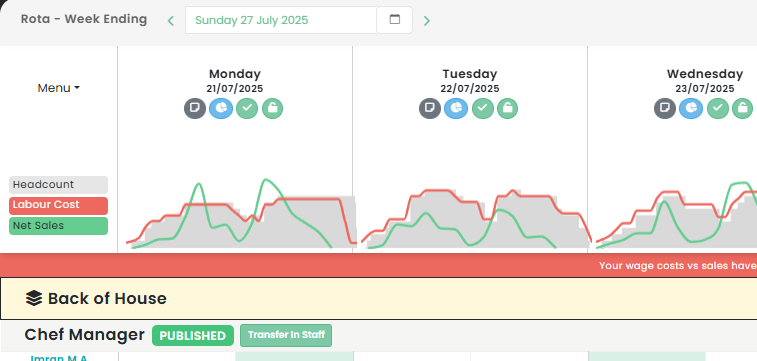Maximizing Restaurant Profits: Understanding the Average Profit Margin in the Restaurant Business for Financial Success in Hospitality
Stay informed with industry news, tips, and practical guides for hospitality professionals.
Average Profit Margin of a Restaurant: A Deep Dive into UK Hospitality
In the world of business, the restaurant industry is a significant player. With its integral role in daily life and its potential for high profitability, it's an alluring sector for many entrepreneurs. However, understanding the average profit margin of a restaurant is crucial for financial success in restaurants.
Understanding the Restaurant Business
To comprehend the financial landscape of the restaurant industry, one must first grasp the concept of profit margin. The profit margin is the net income a restaurant earns after subtracting all costs directly related to the production of goods and services. It's a critical indicator of a restaurant's financial health and sustainability.
Profitability in the Hospitality Industry
The UK hospitality sector, which includes the dining industry, is a diverse and dynamic field. Profitability in hospitality is influenced by a range of factors, from the location's popularity to the quality of service provided. In the restaurant business, the food service profit margin typically ranges from 0% to 15% after accounting for all expenses, such as food, beverages, staff salaries, and overheads. However, this percentage can vary greatly depending on the specific circumstances of each restaurant.
Maximising Restaurant Profits
Given the competitive nature of the restaurant industry, maximising restaurant profits is often a top priority for owners and managers. Effective restaurant operations and management can significantly influence a restaurant's profit percentage. By mastering aspects such as menu engineering, inventory management, and workforce scheduling, restaurant owners can optimise their profit margins.
Restaurant Revenue and Income
Another vital factor in determining the average profit margin of a restaurant is the establishment's total revenue. This consists of all the earnings a restaurant receives from its operations, including food and beverage sales. Restaurant income, on the other hand, refers to the net earnings after all expenditures have been accounted for. By focusing on increasing revenue and managing expenses, restaurants can enhance their profitability.
Improving Restaurant Profits
Improving restaurant profits involves a combination of increasing revenue and decreasing expenses. On the revenue front, strategies might include offering specials during off-peak hours, hosting events, or diversifying the menu. On the expense side, restaurants can streamline operations, negotiate with suppliers for better prices, and implement energy-efficient practices. By striking a balance between income and expenditure, restaurants can effectively increase their food industry profitability.
Looking Ahead in the Restaurant Industry
The restaurant industry, like any other, is subject to economic fluctuations. However, despite these challenges, there are always opportunities for growth and profitability. With a keen understanding of the average profit margin and a commitment to continuous improvement, restaurant owners can achieve financial success in this demanding industry.
In conclusion, the average profit margin of a restaurant is dependent on many factors, including effective management, revenue generation, and cost control. By understanding these elements and implementing strategic initiatives, restaurant owners in the UK can navigate the delicate balance of profitability in the highly competitive hospitality industry.
Ready to simplify hospitality ops?
We’ve got you.
Speak with an Opsyte expert to see how we help:
- Save hours on staff scheduling and rota planning
- Automate invoice processing and financial insights
- Track live labour costs vs sales in real-time
- Get fast answers and support from real humans
- Automate your P&Ls

“Opsyte transformed our entire back office. Game changer.”
Read articles from our hospitality experts
-
Unveiling the Secrets to Successful Restaurant Business: Understanding Average Profit Margins and Boosting Restaurant Revenue
What is the Average Profit Margin for Restaurants?Understanding the average profit margin for restaurants is vital for anyone involved in the restaurant business. It provides a clear picture of the…...
-
Mastering the Art of Dining: Comprehensive Strategies to Improve Your Restaurant - From Management to Customer Service, Marketing and Beyond
How to Improve Your Restaurant: A Comprehensive GuideIn the highly competitive hospitality industry, improving your restaurant takes more than just a passion for food. It involves a careful balance of…...
-
Leveraging the QSR Industry: Understanding Fast Food Trends, Strategies, and Growth in the Hospitality Business
Understanding the QSR Industry in the UK Hospitality LandscapeThe Quick Service Restaurant (QSR) industry, commonly referred to as the fast food industry, is a significant component of the UK's hospitality…...
-
Maximising QSR Services: An Insight into Trends, Technology, and Growth Strategies in the Fast Food Industry
Embracing the Future of QSR Services in the UK: A Comprehensive AnalysisIn the ever-evolving landscape of the UK hospitality industry, Quick Service Restaurants (QSR services) have emerged as a pivotal…...
-
Unlocking the Secrets of Profitability: An In-depth Analysis of Average Restaurant Profit Margins in the Hospitality Industry
Understanding the Average Restaurant Profit Margin in the UK Hospitality IndustryThe restaurant industry forms a significant fraction of the UK's hospitality industry. As an industry that's intrinsically linked to consumer…...
-
Boosting Your Business: Innovative Bar Promotional Ideas and Marketing Strategies to Increase Sales and Traffic
10 Innovative Bar Promotional Ideas to Boost Your BusinessThe UK's hospitality industry is a vibrant and competitive space with bars and pubs at its heart. As a bar owner or…...
